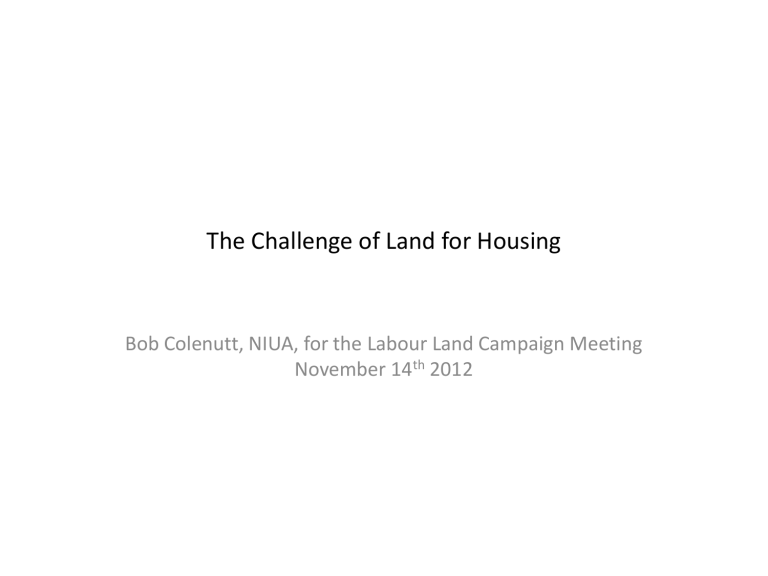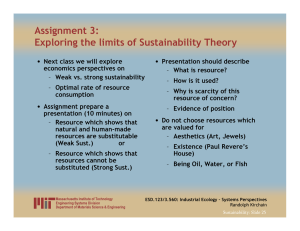Labour Land Campaign

The Challenge of Land for Housing
Bob Colenutt, NIUA, for the Labour Land Campaign Meeting
November 14 th 2012
What this presentation covers
• The housing supply crisis; who is to blame?
• Case study of the Growth areas
• Lessons for a Comprehensive Planning and Land Policy
The housing supply crisis - who is to blame?
• The problem - Housing delivery 1/3 of annual requirement of approx.
300k per annum
• It’s the planners not granting pp.
• No it’s the landowners not releasing land
• It’s the housebuilders rigging the market
• It’s NIMBYism – local people don’t want housing in their back yard
Crisis of housing delivery ; completions in England
• Completion target approx. 250,0000 per annum
• 2000-1 133,260
• 2001-2 129,870
• 2002-3 137,740
Rapidly rising house prices
• 2003-4 143,960 Sustainable Communities Plan
• 2004-5 155,890 Barker Review (call for 70k more)
• 2005-6 163,400
• 2006-7 167,870
• 2007-8 167,680
• 2008-9 144,990
• 2009-10 119,910
• 2010-11 107,890
• 2011-12 118,190
Credit Crunch
Recession
Strategic Land Banks (Potential housing units)
• NE 13,000
• Yorks and Humber 47,000
• E Midlands
• E of England
68,000
249,000
• Gtr London
• South East
• South West
• Wales
227,000
124,000
56,000
26,000
• West Midlands
• North West
• Scotland
• Total
• Source; Times, 6.9.12
57,000
56,000
69,000
992,000
Case study of the Northamptonshire/Milton Keynes Growth Area
• Aims – To assess housing delivery under the New Labour Growth Areas programme 2004-2010. Did the MKSM growth areas programme work and if not what are the lessons for planning and land policy.
• Interviews with local authorities, developers, communities and agencies covering period 2004-present
• Perspectives on “growth”; plans, policies; targets; politics; and local delivery vehicles
• Perspectives on “sustainability”; policies; funding; delivery
• Perspectives on the way forward/alternative models (next year)
The Growth Agenda
• Growth Areas assumption was a) the private sector would deliver (b the role of planning was to make land available
• “No one was in charge of MKSM. Nobody was pushing it. It was not a brand. The growth agenda assumed that if you drew up a plan the private
sector would deliver it”. Govt officer
• Ambitious step change housing targets were set along with intricate sustainability policies but no-one assessed whether the private sector could/would deliver, or asked whether the trajectories were realistic
• Programme slippage before the crash particularly on large sites which required significant infrastructure
Sustainability – What Happened
• “there was a real desire to improve standards but developers saw it as an imposition. There was never a meeting of minds. Very few of the developments we had when we started got delivered, so you did not get
sustainability.” (local authority officer)
• “the idea was to facilitate growth not to aim for quality”. (LDV officer)
• :“there is no problem in principle about sustainability but the planners did not know what they wanted. Value and viability drive everything but the planners do not look at this. There is nothing about the word sustainable
that changes the criteria for development”(housebuilder interview)
• Quality got sacrificed quite early on (as early as 2006) as Gov. anxiety about numbers set in, leading to watering down of sustainable development and the Egan Wheel concept
Viability versus standards
• “the sustainability agenda is an additional cost item for the industry. But it’s a given, the industry adapts to the regulatory burden, and it is reflected
in the value of the house......” (housebuilder interview).
• “If viability falls then so must standards” (housebuilder)
Lessons for Land Policy
• We need a comprehensive land policy – now is the time See PNUK Manifesto.
Land Taxation only deals with a small part of the land problem
• A Planning and Land Policy should cover;
• Inversion of the relationship of dependency on private sector delivery– the private sector cannot deliver without v. significant local and central government intervention
• Strategic planning must be reinvented; local authority Core Strategies need clear allocations and deliverable standards which must prevail over viability claims
• Local communities must be heavily involved – If there are no clear benefits they will say no; and they may say no anyway –is there a way around this?
• There must be a range of mechanisms to bring private sector land forward - to break the stranglehold of options; using CPOs; and placing legal time limits on options
Lessons continued…
• Smarter Government intervention – Do not sell Public land; retain the benefits in the community -revisit New Towns; use leverage of infrastructure funding to obtain community benefits
• Facilitate community land ownership e.g Letchworth; MK Parks Trust; Coin
Street – by allowing community charities and trusts to obtain land at less than market value/ or by giving communities options on parts of large sites; at the same time strategic funding vehicles for community led development must be created
• Acknowledge the limits of S 106, Roof Tax or CIL – these mechanisms can only deliver a small proportion of sustainable development – i.e.
Government and or /institutional funding for infrastructure is necessary
(its an investment!)
• Transforming the housing delivery model from short term to long term.
Can a long term private or institutional approach to land development and stewardship be introduced? If not, what are the alternatives?



